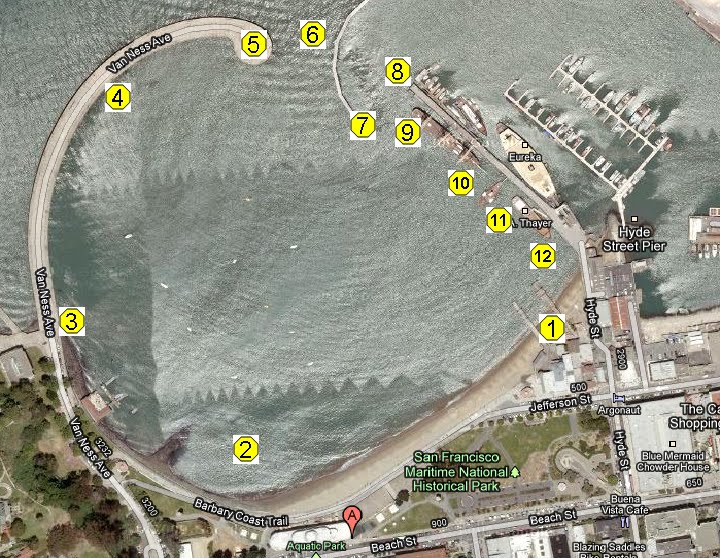Wednesday 12/23/09
I have around 25,000 yards of catch-up drill under my TYR now. Coach Val was absolutely right. This drill makes it impossible to backslide to my old “boogie woogie” stroke. The new style is almost starting to feel ingrained and the sense of sleek propulsion is just delightful. It’s difficult to judge whether I’m faster but in the Dolphin Club NYD Alcatraz qualifier last Saturday, I did finish ahead of people who normally beat me. More importantly, my finish earned me a shower without waiting in a long, cold, shivering line. I also nabbed a seat on the top bench of the sauna. That was a surprising treat given how many men showed up for the swim, many of them quite fast.
Coach has been assigning me all-drill workouts that start with something like ten, three hundred yard stretches punctuated by twenty second breaks between. Then, he’ll have me swim declining intervals of 500 yards, followed by 400, followed by 300, followed by 200, followed by 100. Then he’ll make a video of my stroke for a few lengths of the pool. Last week, we reviewed the first video recording together. It was painful for me to watch, but he was quite pleased. He said rather gleefully, “Your Dolphin friends ask me what I do to you. They say your stroke completely different.” Then he intoned, “This your new stroke. With this stroke, you can swim English Channel. With old stroke ….” At this he pursed his lips, looked down, and shook his head gravely as if contemplating a ship foundering on a leeward shore in a strong gale.
On Tuesday, he had me swim catch-up drills for about an hour and a half. Then he said, “You ready for next step.” He again showed me the “real freestyle” stroke which looks like “almost catch-up.” One hand stays pointed at the end of the swim lane while the other completes a full pull-through and returns forward to just past the head. Slightly before getting touched, the gliding hand begins its pull-through as the other one assumes the glide position and points toward the end of the lane. With this slight adjustment, the stroke generates all the power and glide provided by the catch-up drill while maintaining the maximum possible momentum.
Some time ago, a friend of mine taught me a phrase borrowed from his European friends, “Strong like ox—smart like tractor.” He would illustrate by flexing his biceps and then pointing fingers to each side of his head. A vivid picture of my friend runs through my head as I ply the pool lanes. The catch-up drill is “strong like ox.” The nearly catch-up is the “smart like tractor” part.
Just before I left the pool, Coach showed me a faster turn. My custom has been to grab hold of the pool gutter at the end of the lane and leverage my body around 180 degrees. Coach Val demonstrated a maneuver where the lead hand pushes vigorously against the wall, reversing the upper torso direction while the legs bend at the knees and continue sliding forward. The trailing hand remains pointing at the opposite end and is joined in a diver’s clasp by the one that pushed off the wall. The legs are naturally coiled in a position to immediately jet away from the wall. When executed properly, in one continuous and flowing motion, the swimmer maintains a streamlined profile and reverses course like a darting fish. Coach pointed out that this new turn technique provides a much shorter rest period between changes of direction and provides a better approximation of open water swimming.
He also took me through a brief equipment checklist. “What goggles you use in Channel?” I pointed to the ones on my head. “No allergy?” he asked. I shook my head. “No fogging?” I shook my head. “No leaking?” I shook my head. He said, “Good. Now swimsuit. What you use in Channel?” I pointed to what I was wearing. He asked about chafing or other discomfort. Getting no complaints, he cautioned, “Make sure not too tight. Then can’t pee. And not too loose. Then will cause drag.” The next topic was food. “What you eat?” I told him about Carbo-Pro and the brief testing I’d done. He strongly cautioned me to try it on longer swims in the Bay to ensure no adverse reaction. He also advised me to take along a backup food in case of a sudden change of metabolism mid-Channel. He was happy to hear that Lindsay was going to be the crew chief on the boat, taking charge of feeding and video documentation. He said, “Make sure you work out signals so she knows what you want—water, food, whatever.” I told him that was one of the things we planned to practice on the longer Bay training swims. He smiled and said, “I think you make it. No problem.”
Leaving Koret, I went to the Dolphin Club and swam a big cove putting another four squares up for the Polar Bear. It was a rough and windy day, but my new stroke slid forcefully through the chop. As I sliced through the waves I kept repeating to myself in a Texas two-step rhythm, “Strong like ox—smart like tractor.”
4 years ago

